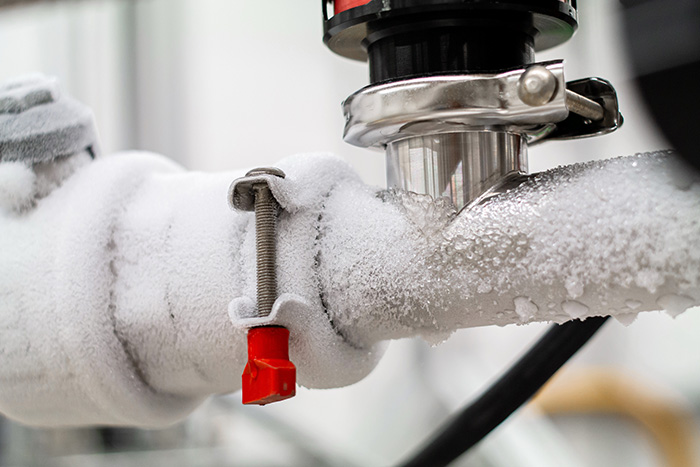Protecting Against Frozen Plumbing: Top Methods for Winter
Protecting Against Frozen Plumbing: Top Methods for Winter
Blog Article
This great article listed below about Prevent Frozen Pipes is quite fascinating. Give it a try and make your own personal findings.

Winter can ruin your plumbing, specifically by freezing pipes. Right here's how to prevent it from taking place and what to do if it does.
Intro
As temperatures drop, the risk of frozen pipelines boosts, potentially resulting in expensive repair services and water damages. Understanding how to stop icy pipelines is critical for homeowners in chilly climates.
Prevention Tips
Protecting at risk pipelines
Cover pipelines in insulation sleeves or utilize warm tape to safeguard them from freezing temperatures. Concentrate on pipelines in unheated or external locations of the home.
Home heating techniques
Keep indoor spaces adequately heated, especially locations with plumbing. Open up closet doors to allow cozy air to circulate around pipes under sinks.
How to recognize icy pipelines
Look for decreased water circulation from taps, uncommon odors or sounds from pipelines, and noticeable frost on subjected pipes.
Long-Term Solutions
Architectural adjustments
Think about rerouting pipes away from outside wall surfaces or unheated locations. Include additional insulation to attics, basements, and crawl spaces.
Updating insulation
Buy high-grade insulation for pipelines, attic rooms, and walls. Correct insulation helps maintain regular temperatures and reduces the threat of frozen pipes.
Securing Outside Plumbing
Garden tubes and outside faucets
Detach and drain yard tubes prior to winter months. Install frost-proof faucets or cover outside taps with shielded caps.
Understanding Icy Pipes
What creates pipes to freeze?
Pipelines freeze when revealed to temperature levels listed below 32 ° F (0 ° C) for extended periods. As water inside the pipes ices up, it broadens, taxing the pipeline wall surfaces and potentially causing them to break.
Dangers and problems
Icy pipelines can lead to water disruptions, home damages, and costly fixings. Ruptured pipelines can flood homes and cause comprehensive structural damage.
Signs of Frozen Pipeline
Recognizing frozen pipes early can prevent them from bursting.
What to Do If Your Pipes Freeze
Immediate actions to take
If you suspect icy pipelines, keep taps open up to soothe pressure as the ice melts. Make use of a hairdryer or towels taken in hot water to thaw pipelines gradually.
Final thought
Avoiding frozen pipelines needs aggressive measures and fast reactions. By understanding the reasons, indications, and safety nets, homeowners can secure their plumbing during cold weather.
6 Proven Ways to Prevent Frozen Pipes and Protect Your Home
Disconnect and Drain Garden Hoses
Before winter arrives, start by disconnecting your garden hoses and draining any remaining water. Close the shut-off valves that supply outdoor hose bibs and leave the outdoor faucet open to allow any residual water to drain. For extra protection, consider using faucet covers throughout the colder months. It’s also important to drain water from any sprinkler supply lines following the manufacturer’s directions.
Insulate Exposed Pipes
Insulating your pipes is an effective way to prevent freezing. Pipe insulation is readily available at home improvement stores and is relatively inexpensive. Pay close attention to pipes in unheated areas such as the attic, basement, crawl spaces, or garage. Apply foam insulation generously to create a buffer against the cold. You can also wrap your pipes in heat tape or thermostat-controlled heat cables for added warmth.
Seal Air Leaks
Inspect your home for any cracks or openings that could let in cold air. Seal any holes around the piping in interior or exterior walls, as well as the sill plates where your home rests on its foundation. Additionally, make sure to keep your garage door closed unless you’re entering or exiting. Leaving it open creates a significant air leak that can lead to frozen pipes.
Allow Warm Air Circulation
During cold snaps, it’s essential to allow warm air to circulate evenly throughout your home. Leave interior doors ajar to promote better airflow. Open kitchen and bathroom cabinets to help distribute heat consistently around the rooms. If you have small children or pets, be sure to remove any household chemicals or potentially harmful cleaners from open cabinets for safety.
Let Faucets Drip
A small trickle of water can make a big difference in preventing ice formation inside your pipes. When temperatures drop significantly, start a drip of water from all faucets served by exposed pipes. This continuous flow helps prevent the water from freezing. Additionally, running a few faucets slightly can relieve pressure inside the pipes, reducing the chances of a rupture if the water inside does freeze.
https://choateshvac.com/6-proven-ways-to-prevent-frozen-pipes-and-protect-your-home/

As a passionate person who reads on How to prepare your home plumbing for winter weather, I assumed sharing that excerpt was a smart idea. In case you liked our blog posting please make sure you remember to pass it around. We recognize the value of your readership.
Click Here Report this page